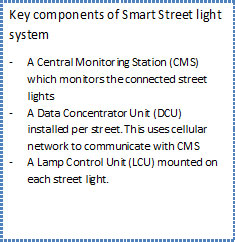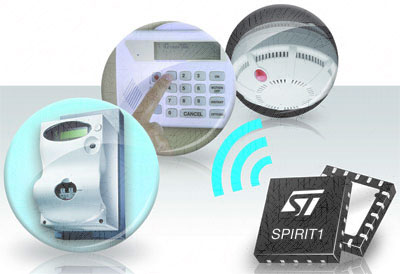 “Contemporary street light systems suffer from problems like inefficiency, power wastage, power pilferage, cumbersome maintenance and crimes on the highways due to stretches roads because to faulty street lights. Smart street light management systems address all of these issues.”
“Contemporary street light systems suffer from problems like inefficiency, power wastage, power pilferage, cumbersome maintenance and crimes on the highways due to stretches roads because to faulty street lights. Smart street light management systems address all of these issues.”
A significant portion of the national electricity production goes to street lighting. The existing street lighting systems world over are not very efficient and optimized. We can still find street lights switched on during day time. Imagine thousands of street lights consuming thousands of watts of electricity on highways wasting away precious electricity. It also reduces the usable life of the lamps. This gives us a substantial scope for improvement in the way street lighting systems operate today. The suggested approach in bringing about improved operation efficiency focuses on two aspects, namely, replacing existing lamps with LEDs lamps and making the street lights ‘smarter’.
The purpose of this article is to explain one of the reference platform developed by STMicroelectronics for building such ‘smart’ street lighting systems.
The transformation from classic street lighting system to a ‘smart’ streetlighting is primarily due to the ability communicate. This interlinks the various components of a normal street lighting system through a communication network. This gives the ability to individually control and monitor a single street light or a city full of street lights. The advantages of such a system are:
- Control the on-off timings and parameters like intensity of an individual street light to attain the maximum efficiency.
- Identify any wastage in power due to street lights being on during the daytime (or when there is still some light)
- Identify any fault conditions in the street light remotely and scheduling appropriate maintenance activity.
- Monitor the operating parameters to detect end of age of a street light even before it actually stops working.
- Warn about power pilferage and theft of street light parts.
Advantages a ‘Smart’ street lighting system offers in terms of the maintenance activity is often underestimated. The ability to identify a faulty street light from a central location and to send a crew only to repair that particular street light offers huge savings in time and money over the current approach of having to dispatch maintenance crew to check all the street lights one by one over a period of time as a routine activity.
Smart Street Light System
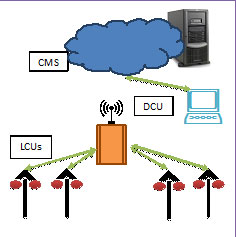
Current Systems

The existing solutions are based on either of the following techniques
- Manual switches: This is the classic and omnipresent technique. Switching of the lights is done by human attendant.
- LDRs: Light dependent resistance based lights can switch themselves according to the ambient light conditions. Tolerance variation in LDRs require manual tuning of threshold levels in individual lights typically using potentiometers. Dust deposits can also affect the sensitivity. Such factors reduce reliability and may also cause lights to switch on at slightly different times.
- Astronomical Timers: These devices choose switch on-off time depending on the date on the calendar. The devices are preprogrammed according to the location of the installation. This scheme is inflexible, does not take care of the variable light situation (overcast, dust storm etc.).
All of the above systems are simple, economical and easy to install. However these systems are not flexible and do not lend themselves for modern day power saving strategies. They provide limited monitoring capabilities.
Smart street light management system overcome these limitations while providing below features or capabilities…..
- Capability to remotely switch on-off lights
- Dimming and scheduling capabilities.
- Ability to detect and report faults. Such systems can detect fault in the lamp as well as the driving circuit. Can detect over and under voltage situations, presence of humidity in enclosure and operating temperature among others.
- Detect presence of pedestrian / vehicle to switch on lights on approach
- Measure the power consumed by the light and detect power theft.
- Detect accidents / damage to the pole using motion sensors.
- Monitor additional parameters like pollution level, noise and ambient light level
Anatomy of Smart Street Light System
Each street light has an active unit called LCU which controls the lamp and communicates with the DCU. The LCU also monitors the lamp status and report any malfunction to the DCU. The network can be made robust using mesh networking. In this case each LCU acts as a mesh node. Each mesh has a master unit called DCU (Data Communication Unit). The DCU acts as a root node for the mesh and provides the connectivity with the backhaul network. If a DCU fails or goes out of backhaul network, its child nodes can join adjacent mesh network. Once the failed DCU is online again the child nodes join it again. The subsystems of a smart street light system are described in details as follows.
Central Monitoring Station (CMS)
CMS is typically implemented as a web application running on cloud platform. The central monitoring station provides facilities for commissioning, administration and monitoring of each street light node. The network can be organized in terms of streets. The CMS can store the geographical location, serial number and encryption keys of a DCUs in a database.
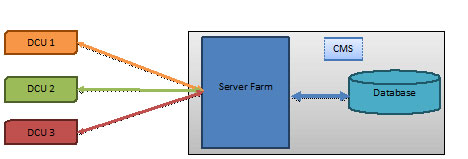
CMS system provides a remote interface to install new lights and register them in the system. It provides features to update settings of a LCU like network affinity, radio channel, parent DCU etc.
CMS gets the real-time operational information at the street light level from the DCUs.It presents the information on a dashboard interface in to the user via a web interface. The operators can also see a bird’s eye view of the entire system on a map. They can pin point any problems using the indicators which can be displayed on the map.
CMS can be configured to raise an alarm when specific conditions arise. It can run diagnostic tests and reports via SMS, mail, audio visual alarm. It also allows the operator to program on off schedules in the LCUs, change light etc.
The CMS can use multiple communication techniques to communicate with the DCUs
- It can use simple HTTP request based communication to communicate with the DCUs. Such approach is very simple to implement but also suffers from some limitations. HTTP is a connectionless request-response based protocol which introduces some latency in the system. The server has to wait for client (DCU) to make a request beforeit can send a command to the DCU.
- The CMS can use protocols like MQTT / web sockets to have a persistent connection. These techniques allow for near real time full duplex communication. Using these technique server can notify / push a command to the DCU at any time.
- In areas where wireless networks are not available. The DCU can communicate using the Unstructured Supplementary Service Data (USSD), in collaboration with the network operator.
Data Communication Unit (DCU)
Typically a DCU services one or two streets depending upon the number of street lights in each street. Each DCU has the capability to communicate with 30-50 LCUs in a mesh network. To ensure good network performance care should be taken that the adjacent mesh network use a different radio channel. Low-power RF transceiver in the Sub GHz band like SPIRIT1 from STMicroelectronics can be a good choice. It requires small number of discrete components and integrates a configurable baseband modem, which supports data management, modulation, and demodulation. On the stack side Low power Wireless Personal Area Network like 6LoWPAN can be used to make a mesh network among multiple LCUs.
The DCU has on board GPRS/3G module which communicates with the MCU using on chip USART. In case of unavailability of cellular network mechanical switches can also be used to switch on-off the associated street lights. DCU can be built around microcontroller like STM32F from STMicroelectronics which serves as the brain of the unit. It has on chip peripherals required for this application like USART, RTC, and SPI etc.
DCU can also incorporate metering IC like STPM32to measure the power being used by the entire street. Power pilferage can also be detected by putting metering ICs on each street light and then comparing the supplied power with the total power consumed by all the street lights together.

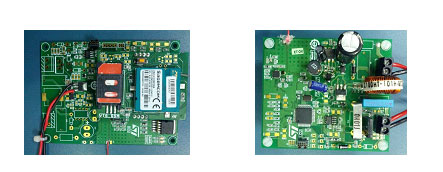
Light Control Unit (LCU)
The LCU can be retrofitted into an existing street light or added as part of a new street light, providing the ability to control, configure and monitor the street light. The various control features provided by the LCU are ability to Turn ON/OFF and Dim the intensity of the street light. The LCU also measures the Voltage and Current at the street light and transmits this information to the CMS periodically. The LCU can continue to switch on-off the individual street light using the last received scheduling information to keep the system working even if the network breaks down.
The major components in an LCU are
- A STM32L15x 32 bit ARM cortex-M3 microcontroller.
- TRIAC circuitry for control of the Street Light (like ACST8 with over voltage protection from STMicroelectronics).
- Sub-Ghz RF transceiver. (like SPIRIT1 low power sub GHz transceiver from STMicroelectronics)
- Op-amp based monitoring circuit (like LMV358 low power rail to rail op-amp from STMicroelectronics).
- Optional metering IC to measure power consumption
- Auxiliary power supply (based on converters like Viper16 high voltage converter)
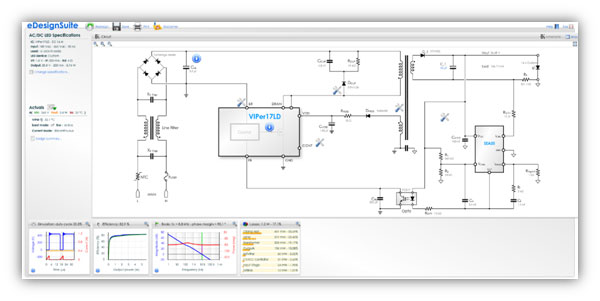
Conclusion
Smart street lights are a bit costlier than their classic counterparts but they can repay the additional cost within a few years period. Smart street light systems can be integrated with the city wide infrastructure realizing the concept of smart cities. Besides enabling huge electricity savings and reducing CO2 emissions. These lights work in tandem with other smart infrastructure and make the lives of residents safe and comfortable. Huge savings and easy maintenance make them an ideal choice for the infrastructure developers.



